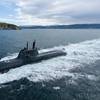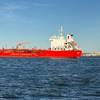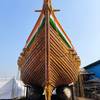A variety of Naval Sea Systems Command programs will make their debut with the USS Abraham Lincoln (CVN 72) Battle Group, which recently departed for a six-month deployment in support of Operation Enduring Freedom.
The battle group deployed with several Navy, next generation technologies, including the Man Overboard Indicator (MOBI) on Lincoln and several other ships in the battle group, Naval Fires Network (NFN) throughout the battle group and the Area Air Defense Control (AADC) aboard USS Shiloh (CG 67).
The deployment gives the Navy an opportunity to assess these technologies
and look at new ways to improve efficiency and warfighting capabilities
using current resources and the latest technology.
MOBI is a personal water or manually activated alarm system designed to
improve the safety of Sailors involved in operational situations that create
a potential for falling overboard. MOBI uses a series of transmitters to
aid in the detection, location and recovery of Sailors who fall overboard.
NFN is a network-centric warfare family of systems that provides near real
time intelligence correlation, sensor control, target generation, precise
target coordinates, moving target tracks, mission planning and battle damage
assessment capabilities to support more timely engagement of time critical
targets. This capability will allow Lincoln to share a greatly improved
battlespace picture very quickly with other ships in the battle group, and
with Army and Air Force sites in the Southwest Asia area of operations.
NFN consists of three existing systems: Naval Sea Systems Command's
Tactical Exploitation System - Navy (TES-N), the Joint Services Imagery
Processing System - Navy (JSIPS-N) under Naval Air Systems Command, and the
Global Command and Control System - Maritime (GCCS-M) from the Space and
Naval Warfare Systems Command, along with improved interfaces among them.
AADC is a state of the art, integrated, Theater Air Defense (TAD) battle
management system, which provides air defense planning and current
operations support capability. AADC enhances situational awareness,
reduces planning time, minimizes mission redundancy, minimizes waste of air
defense assets, reduces the risk of fratricide, and allows weapons systems
to be used to their full range of capability.
The Lincoln Battle Group will relieve the USS George Washington (CVN 73)
Battle Group upon arrival in the Arabian Gulf.
Source: NAVSEA
April 2025
 Read the Magazine
Read the Magazine

 Read the Magazine
Read the Magazine
This issue sponsored by:

Navigating the Future of the Maritime Industry
Subscribe for
Maritime Reporter E-News
Maritime Reporter E-News is the maritime industry's largest circulation and most authoritative ENews Service, delivered to your Email five times per week












